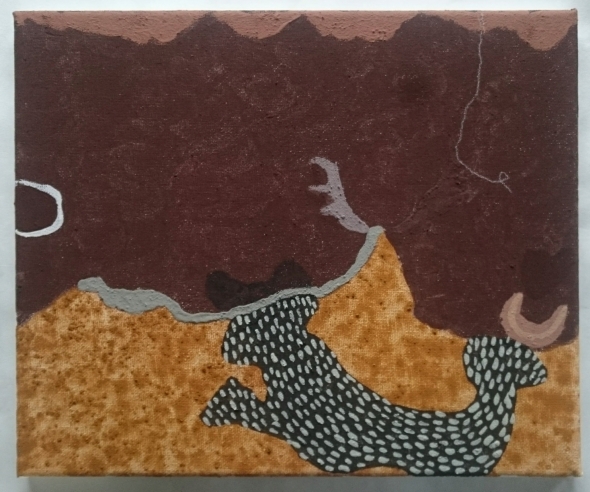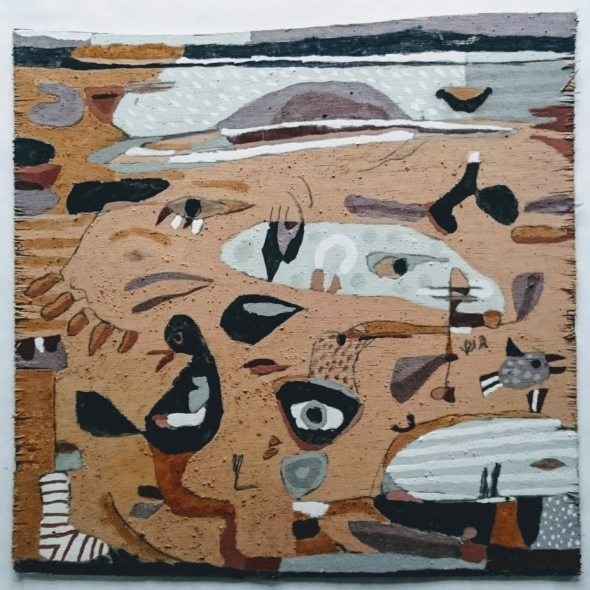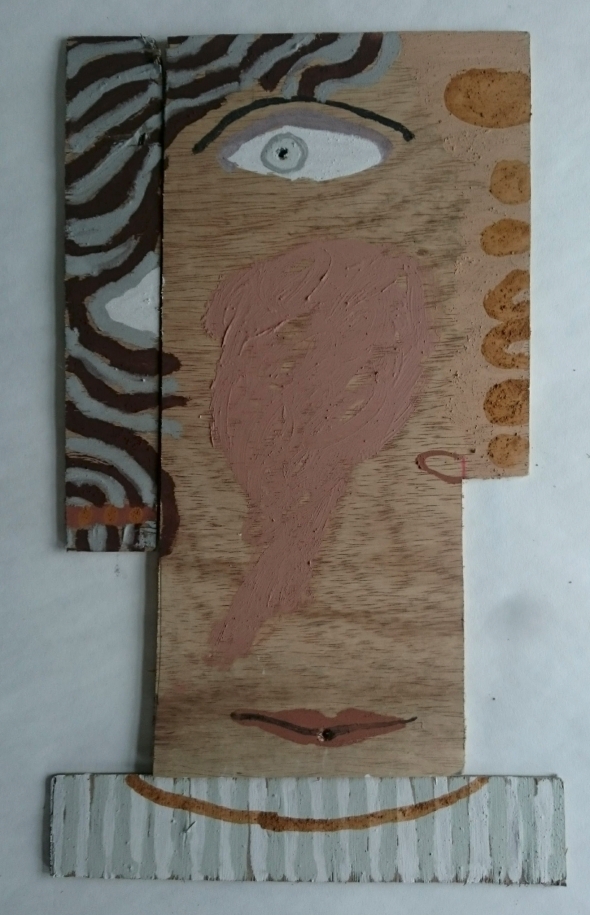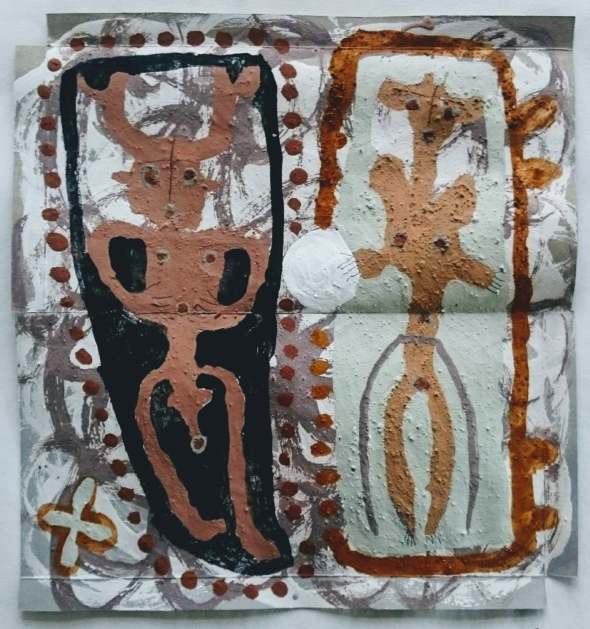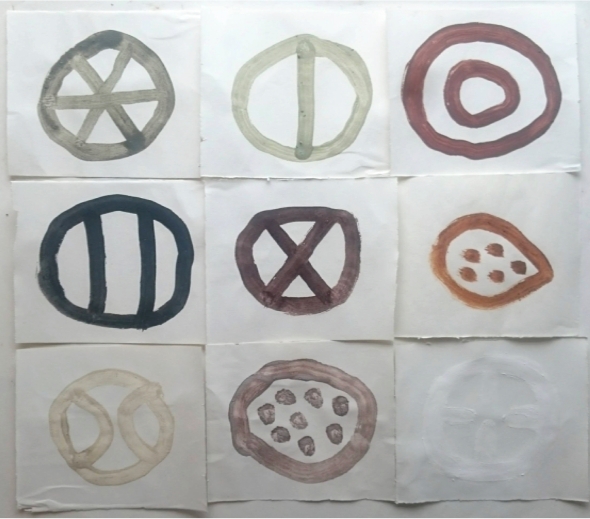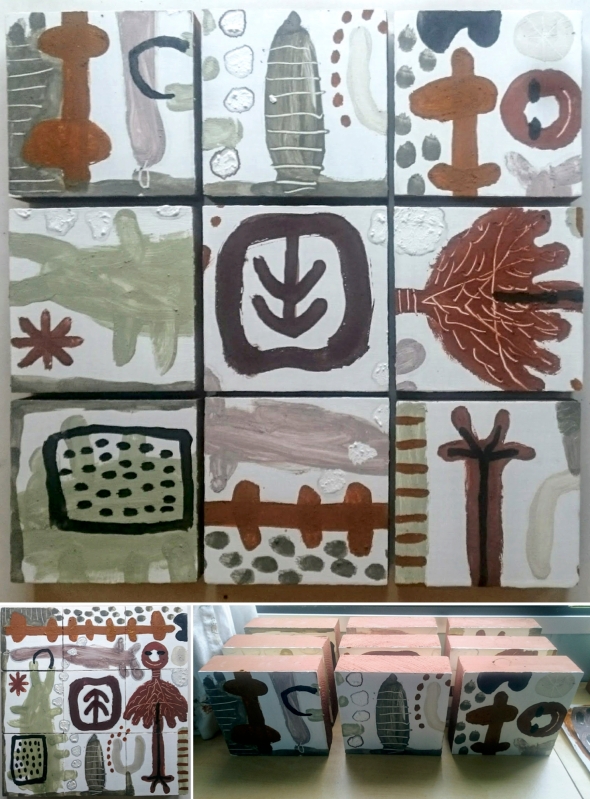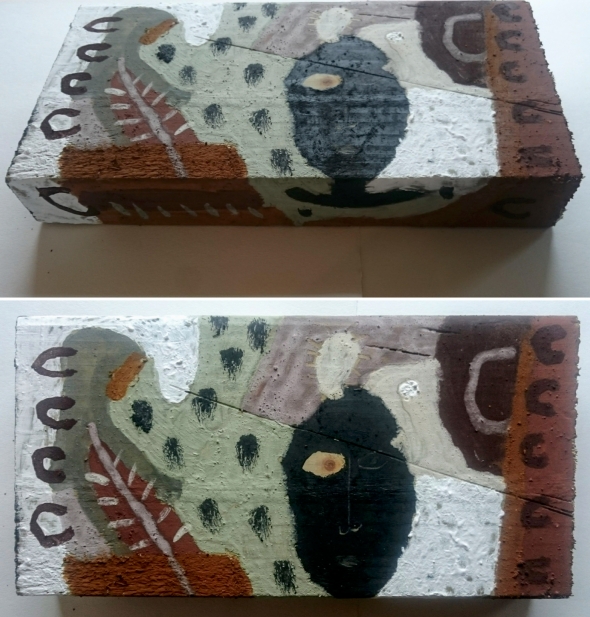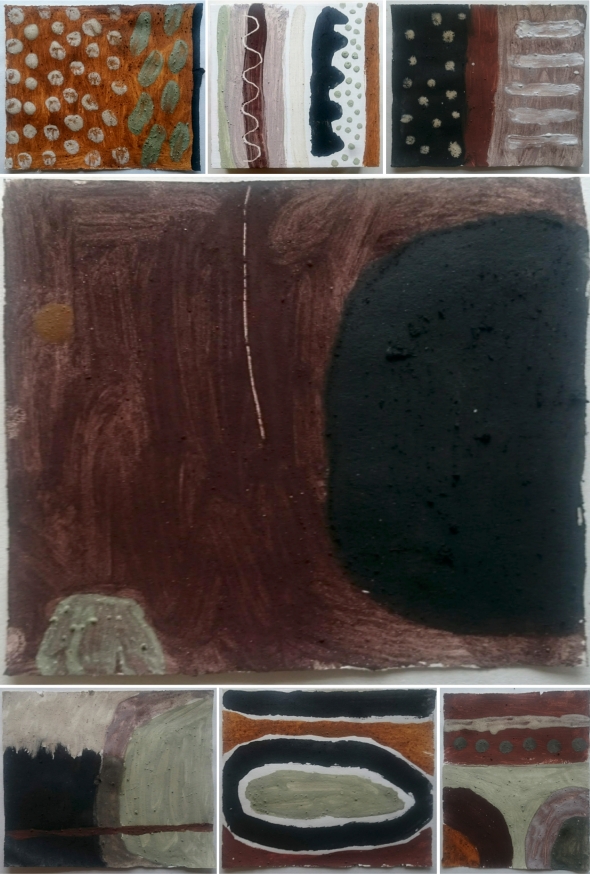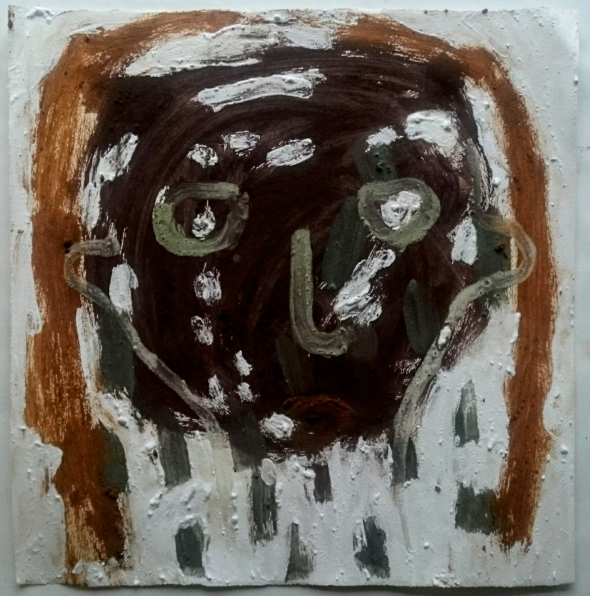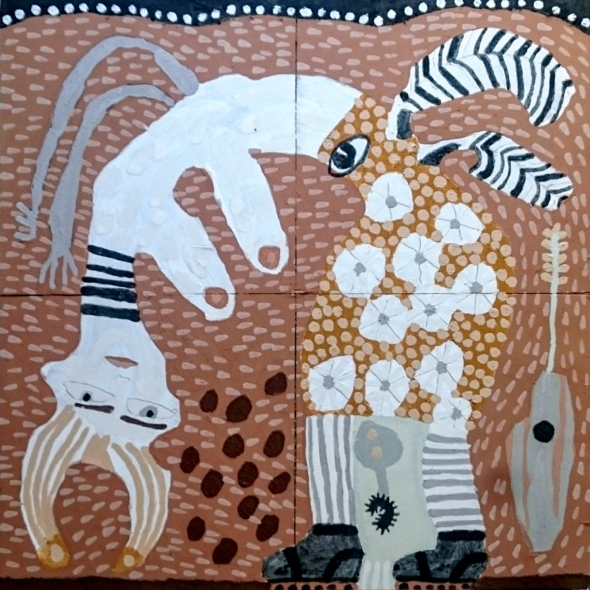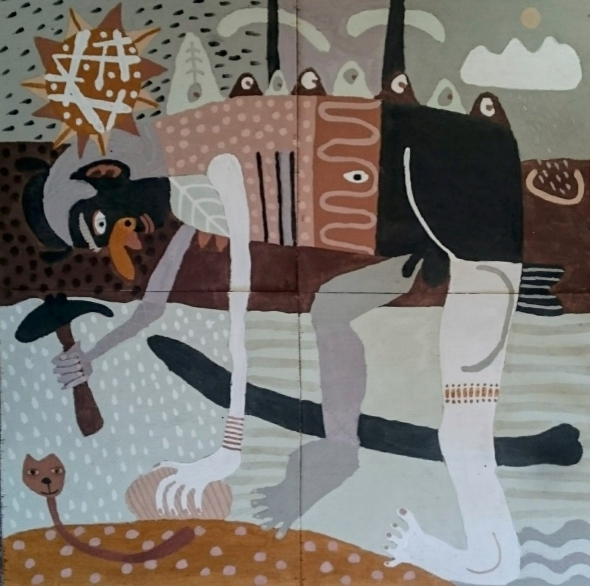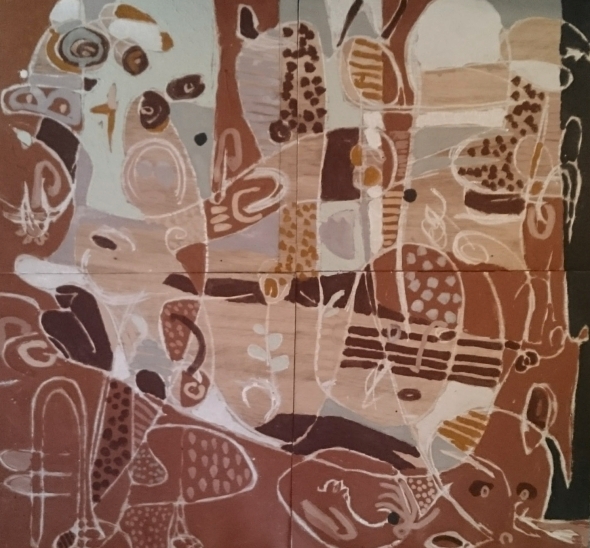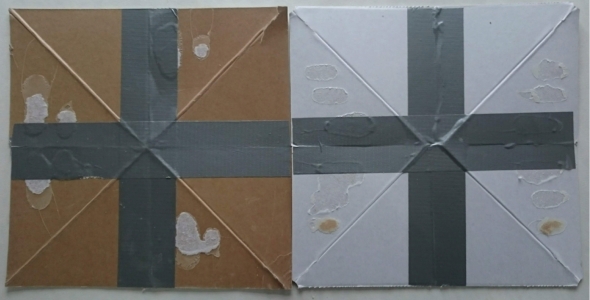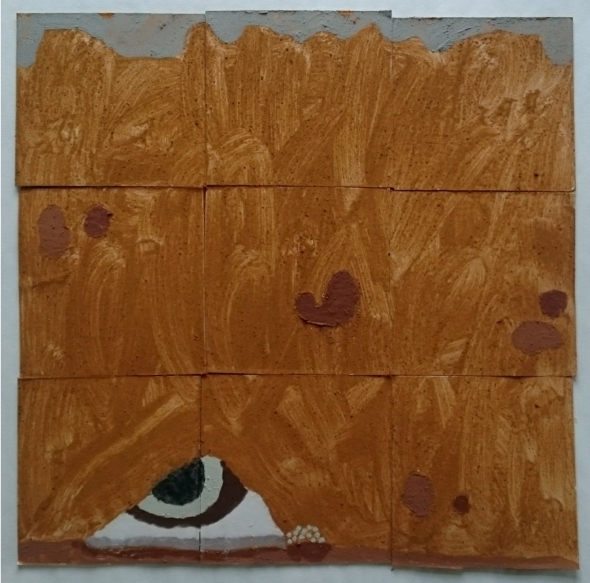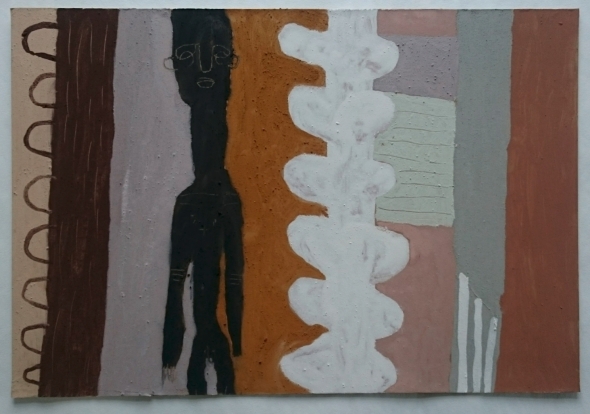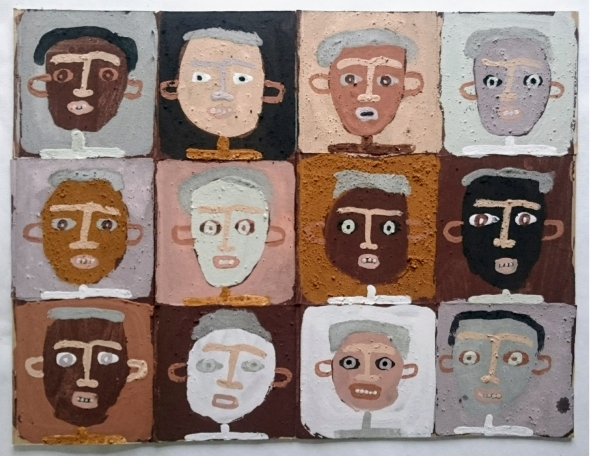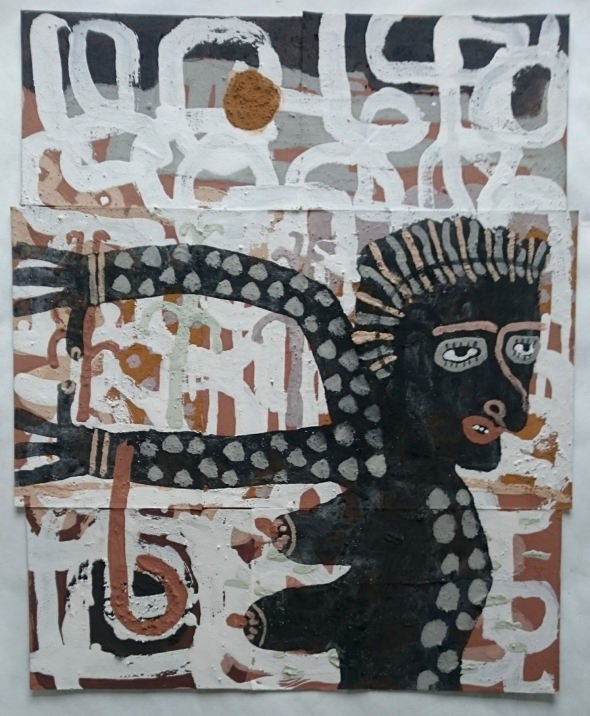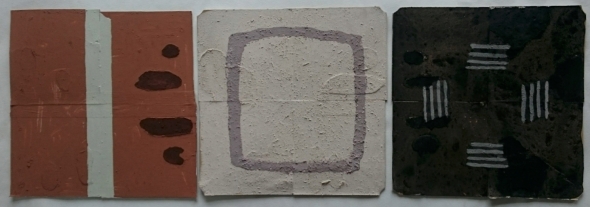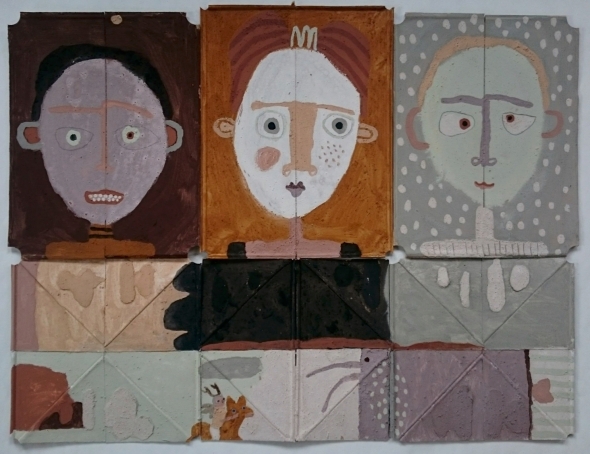and yet…
Posted: September 10, 2019 Filed under: activ8, the ash tree | Tags: art and science, Arte Povera, climate crisis, climate emergency, eco art, ecopsychology, Feeling, Interdisciplinarity, Meditation, poetry, Prayer Leave a commentthis climate emergency, part 2
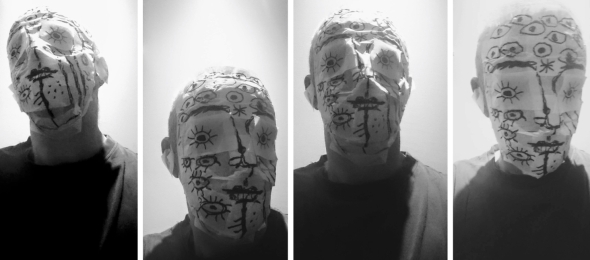 drawing on my face 4: seeing (masking tape and marker pen on human head) © p ward 2019
drawing on my face 4: seeing (masking tape and marker pen on human head) © p ward 2019
and yet,
the sun and moon still rise and fall
birds sing
grass grows
everything is somehow in place.
despite imagery evocative of an abrupt demise,
despite rising popular opinion and attendant fearful frenzy,
despite the corroboration of a high percentage of scientific peers,
despite indicative physical, ideological and pecuniary global suffering and conflict,
despite a lifelong personal acknowledgement of our continuing abuse of Nature…
I do not sense
I do not feel
the end.
I cannot sense
I cannot feel
the end.
I do not, cannot
and will not accept
the end.
so what of instinct and intuition (the antithesis of science)?
what of individual response?
what of collective consciousness?
what of the uninformed, the common man?
are we, en masse, running from the ensuing fire?
and anyway, where can we run in this apparent global catastrophe?
if I do not feel it,
if I stand aside the mindful stampede,
am I simply burying my head in the sand
in denial of empirical objectivity,
in fear of the inevitable?
or is it that
I do not know within my power what more I may do?
as I stand on this excellent brink of oblivion, this ending of sorts,
with the knowledge, wisdom and capability of all I have before
there is opportunity
there is technology
and there is love.
I must either believe in the magic and wonder of the human spirit within Nature or not
like every day
like any day
I breath
I choose
I act according to (my) Nature…
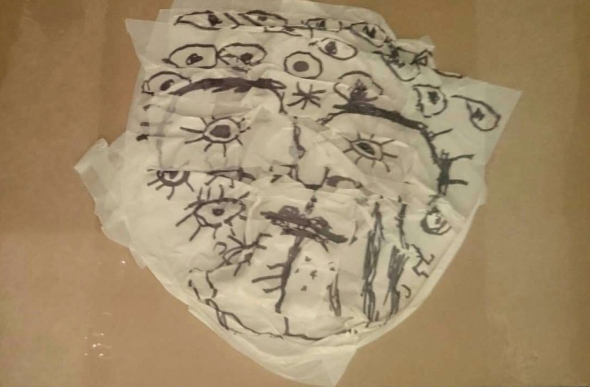 drawing on my face 4: seeing (masking tape and marker pen on human head) © p ward 2019
drawing on my face 4: seeing (masking tape and marker pen on human head) © p ward 2019
© P Ward 2019
painting a parish future – Pendeen in St Just, Cornwall
Posted: November 29, 2018 Filed under: activ8, eARTh, educ8 | Tags: arts research, Cornwall, earth pigments, eco art, Ecology, ecopsychology, Environmental art, indigenous culture, Interdisciplinarity, Mining, painting, Painting Together, Pigment, Visual arts 2 CommentsESRC Festival of Social Science, 10th November 2018
background
I met Dr Joanie Willett at a ‘Melting Pot’ event at Exeter University’s Environmental Sustainability Institute at Penryn Campus in Falmouth, Cornwall. The purpose of the event was to provide opportunities for cross-disciplinary collaborations. Dr Willett was fascinated by aspects of the geology behind earth pigments, particularly of those connected with mining waste, and of the potential for public engagement that my workshops provided. I was intrigued by Dr Willett’s studies around Parish Councils and how to promote public engagement in the political process, reminding me of conversations I had in Australia around the ecological basis of Aboriginal tribal councils.
After a further meeting, held as a walk along the ‘Tin Coast’ in West Penwith between Pendeen and Botallack, we decided to organize a public workshop exploring these principles. Funding was obtained from the Economic and Social Research Council and Exeter University as part of the Festival of Social Science, a national event making Social research accessible to the general public.
where the personal becomes POLITICAL: the idea
Our personal experiences, knowledge and perceptions of the places we live are all valid contributory factors to the cultural truth of a place. In Western democracies the starting point for policy decisions are ideally based in such cultural truths. Parish councils, of which there are some 10,000 in the UK, are the gathering places for the diverse cultural perception of our local communities. Beyond this such cultural perceptions are strongly influenced, if not determined, by the geographical identity, the physical ecology and resources, of a place.
painting a parish future offers a creative space to cultivate and share personal experience, knowledge and future visions of the places that we live.
It is hoped that the creation of such a space within a working Parish may encourage a spirit of commonality and cooperation within groups that may too easily become competitive and detached from the truth of a regions imminent ecology, in respect of all its inhabitants.
painting a parish futureis a collaborative research project led by politics lecturer Dr Joanie Willett and ecological artist Peter Ward in association with Exeter University’s Environmental Sustainability Institute. The project will utilize a shared knowledge of local political process and creative environmental engagement.
An initial enquiry will gather local people, parish councilors and experts to walk and share experiences and knowledge in a reflective process in the Parish of St Just in west Cornwall. The daylong event will culminate in a communal painting using gathered materials to express a shared vision of the future. The painting and further documentation of the event will be exhibited at the ESI at Penryn Campus and at a local venue in St Just Parish.
painting a parish futurewill run alongside ongoing national and local initiatives ‘Going Wild’ with Cornwall Council and the Cornwall Wildlife Trust and the St Just and Pendeen Neighbourhood Development Plan.
The project will provide a model for further actions in local communities across the UK, international research with Indigenous communities in Australia and the basis for an academic paper in relation to such activities, as well as a real focus for community action in the place it is performed.
in practice
The event was advertised locally in the Parish ‘Outreach’ magazine, through flyers in local shops and on notice boards and through personal invitation to relevant experts. It was hoped that we would have a group of about 20 people for the event. In practice, we were fortunate that a County Councilor expressed her interest from an early stage, inviting a simple presentation at a Town Council meeting in St Just to further promote the event. On the day, 2 people who had signed up did not show leaving us with a group of 7, including Dr Willett and myself. While the response was a little disappointing, and indeed raised a very important discussion regarding public engagement, the small number did allow for more focused time and intimate space for discussion and sharing and better engagement with the process.
Part of my personal motivation for the event was to begin to learn more about the place that I live. Both my own background research about the area and the process of organizing the event provided interesting insights into the present social dynamic and historical roots of the parish. Another part was to establish contacts within the community and with relevant organizations for future projects.
 Poster/invitation for painting a parish future – Pendeen in St Just; 7 Cornish pigments, earth colours used in communal painting © p ward 2018
Poster/invitation for painting a parish future – Pendeen in St Just; 7 Cornish pigments, earth colours used in communal painting © p ward 2018
Participants included an artist, a politics lecturer, an environmental educator and project manager, a childminder, County Councilor, Town Councilor and a geologist, providing the basis for lively, diverse and informed discussion throughout the day with many thoughts for positive action being shared.
The morning walk took us through the village of Pendeen to the recently restored leat (a community project initiated by a member of the group), through the historic mining community of Lower Boscaswell, to the medieval ‘holy’ well and then through remains of Geevor Tin Mine and ancient field networks down to the coast, before heading back to the Parish Hall for lunch. Conversation within the group flowed easily between the whole group and individuals and covered topics from local planning policy, local history and geology, the influence of the environment on agriculture, national environmental and political attitudes, interspersed with a shared appreciation of the natural world, and in particular the local environment. Lunch was a homemade vegetable soup, made using exclusively local produce from the community farm, along with local cheese and bread and a splendid array of cake.
Pendeen Parish Hall, photo courtesy J Willett
The process of painting (interesting for my part for the lack of ‘artists’ in the group) took participants a little out of their comfort zones but allowed us to ground our thoughts in a meaningful and enjoyable way. The pigments themselves offered further insights into the local environment, as well as paint making. The painting itself was structured through an approximation of the evolutionary process, starting with imagery around geology, then land use and flora and fauna and lastly human intervention. Despite the initial discomfort, participants recognized the value of the process, at whatever level individuals felt able to contribute, and enjoyed the end result.
painting a parish future – Pendeen in St Just, photos courtesy J Willett and M Ward
conclusion and further action
Despite the somewhat disappointing public response to the event, it was agreed that it had been a useful and inspiring day with everyone feeling they would use what they had learnt in some way. Some said they ‘had never participated in anything like it before’ and that it had revealed a new way of working in the public sphere. I was personally encouraged by how everyone got involved with the process and in particular how the act of painting with local pigments was enjoyed and valued.
As a facilitator, whenever I approach an event such as this I will necessarily fill my mind with any relevant information I wish to share and a structure I aim to run the day through. In practice, especially when working with adults, it is essential that such plans are held merely as guidelines and that the process and dynamic of the group are allowed to express themselves for a satisfactory outcome to be achieved. Indeed, it is inherent to the process that the day is allowed to progress organically within any practical limitations, such as time, space, numbers and sustenance, to be true to itself. What is exciting about such a process is exactly those surprises or unknowns that arise, leading us to new ideas and future actions.
Through contacts made at the Town Council presentation, it is hoped that the painting and research will be exhibited at St Just Library, while also being shared with the Town Council and Local Neighbourhood Development Plan as an example of public engagement. Discussion has already begun regarding further collaboration with Dr Willett with the possibility of developing the event in other areas. Business and public groups in the area have also approached me to run similar workshops for upcoming events.
painting a parish future– Pendeen in St Just, communal painting, earth pigments on board © p ward 2018
Thank you to everyone who participated in the event, for the support and interest of the local community and especially to Joanie for her contributions and collaborative insights.
© P Ward 2018
7 Cornish Pigments: first findings
Posted: August 31, 2018 Filed under: eARTh, educ8 | Tags: art and science, Arte Povera, arts research, British Art, Cornish Art, Cornish mining, Cornwall, earth pigments, eco art, Ecology, ecopsychology, Environmental art, Interdisciplinarity, Mining 1 CommentTHIS TOXIC(?) BEAUTY
 Cornish Landscape (raw and ground Cornish pigments) © p ward 2018
Cornish Landscape (raw and ground Cornish pigments) © p ward 2018
The 7 colours shown here have been gathered close to historic mining sites in west Cornwall. Some are waste products from tin and copper mining and may contain toxic minerals such as arsenic and cadmium, ironically both used historically in paint and pigment production. Despite being found alongside public rights of way until sufficient mineral analysis has been made of the samples I am unable to share them with the public.
However, I am comfortable enough to start using them myself (with care). Inspired by the milling process used to extract tin I have started to mix the raw materials with water before filtering with a fine sieve. This minimizes the grinding process and hence the possible inhalation of dust. So far I have only used PVA glue as a binder but enjoyed the difference in colour, provenance and nature of the pigments compared to the North Devon pigments I am more familiar with. As such the imagery has started to take on its own character relevant to the materials, the geographical space and my personal experience of Penwith and west Cornwall. I am currently working with Geevor Tin Mine Museum to develop educational workshops using the pigments. The mine itself and attendant museum is utterly fascinating allowing me to better understand the differences between pigments from natural landforms and those extracted from deep underground. In due time I will be able to better share my findings but for the time being here are some of my first paintings made using the wonderful, beautiful but maybe a little toxic Cornish pigments.
As yet the paintings are relatively small (up to 60x60cm) but I look forward to taking some of these ideas to a larger scale and context. If you are interested in any of the work shown here or would like to support or contribute to any further research please get in touch.
 7 Cornish pigments – paint samples on paper @ p ward 2018
7 Cornish pigments – paint samples on paper @ p ward 2018
 Cornish Quilt (Cornish earth pigments on paper) © p ward 2018
Cornish Quilt (Cornish earth pigments on paper) © p ward 2018
 6x6x6 (Cornish earth pigments on paper) © p ward 2018
6x6x6 (Cornish earth pigments on paper) © p ward 2018
 red, grey, green (Cornish earth pigments on paper) © p ward 2018
red, grey, green (Cornish earth pigments on paper) © p ward 2018
 grey, green, white, mauve I-III (Cornish earth pigments on wood) © p ward 2018
grey, green, white, mauve I-III (Cornish earth pigments on wood) © p ward 2018
 fox walking (Cornish earth pigments on wood) © p ward 2018
fox walking (Cornish earth pigments on wood) © p ward 2018
 dagdu (Cornish earth pigments on board) © p ward 2018
dagdu (Cornish earth pigments on board) © p ward 2018
 in landscape I-V (Cornish earth pigments on paper) © p ward 2018
in landscape I-V (Cornish earth pigments on paper) © p ward 2018
 botallack black – arches, obliterate, behind a rainbow (Cornish earth pigments on paper) © p ward 2018
botallack black – arches, obliterate, behind a rainbow (Cornish earth pigments on paper) © p ward 2018
 vertical palette (Cornish earth pigments on board) © p ward 2018
vertical palette (Cornish earth pigments on board) © p ward 2018
 untitled – explorations in colour and form I-IV (Cornish earth pigments on board) © p ward 2018
untitled – explorations in colour and form I-IV (Cornish earth pigments on board) © p ward 2018
 falling (Cornish earth pigments on board) © p ward 2018
falling (Cornish earth pigments on board) © p ward 2018
 in relationship I-III (Cornish earth pigments on board) © p ward 2018
in relationship I-III (Cornish earth pigments on board) © p ward 2018
 in relationship – butterfly (Cornish earth pigments on canvas) © p ward 2018
in relationship – butterfly (Cornish earth pigments on canvas) © p ward 2018
 storyteller IV (Cornish earth pigments on canvas) © p ward 2018
storyteller IV (Cornish earth pigments on canvas) © p ward 2018
 bird box (Cornish earth pigments on wood) © p ward 2018
bird box (Cornish earth pigments on wood) © p ward 2018
 4 vertical colours (Cornish earth pigments on board) © p ward 2018
4 vertical colours (Cornish earth pigments on board) © p ward 2018
 sketch I and II (Cornish earth pigments on paper) © p ward 2018
sketch I and II (Cornish earth pigments on paper) © p ward 2018
 house on wheels – sketch (Cornish earth pigments on paper) © p ward 2018
house on wheels – sketch (Cornish earth pigments on paper) © p ward 2018
With thanks to the people and places of west Cornwall. In particular, the staff of Geevor Tin Mine, Fiona, Natasha and of course Francesca and family for your inspiration and support.
© P Ward 2018
please accept my resignation 131016
Posted: October 13, 2016 Filed under: activ8, eARTh, educ8, Uncategorized | Tags: Aesthetics, Arte Povera, arts research, Bideford Black, child art, collaboration, Communication, cycling, dance, Devon, Earth, earth pigments, eco art, Ecology, ecopsychology, Environmental art, Feeling, Interdisciplinarity, Nature, North Devon, North Devon Coast, Pigment, Visual arts 4 Comments
some things I have seen, done and made that have made me think, feel and smile over the last few months…
“Reading true literature [Nan Shepherd] reflected, ‘it’s as though you are standing experiencing and suddenly the work is there, bursting out of its own ripeness . . . life has exploded, sticky and rich and smelling oh so good. And . . . that makes the ordinary world magical – that reverberates/illuminates.’ ” taken from Landmarks by Robert Macfarlane.
 folded paper; little family; special gifts; friendship (earth pigments on canvas) © p ward 2016
folded paper; little family; special gifts; friendship (earth pigments on canvas) © p ward 2016
 wooden tray full of found things © eARTh 2016
wooden tray full of found things © eARTh 2016
 ‘the exmoor beast’!?, exmoor zoological gardens © p ward 2016
‘the exmoor beast’!?, exmoor zoological gardens © p ward 2016
 drawing a line, coast to coast with skedge 13916 © eARTh 2016
drawing a line, coast to coast with skedge 13916 © eARTh 2016
 learning to draw I © p ward 2016
learning to draw I © p ward 2016
 learning to draw II, III, IV © eARTh 2016
learning to draw II, III, IV © eARTh 2016
 towan beach, roseland peninsula; bottallack mines, st just, cornwall © p ward 2016
towan beach, roseland peninsula; bottallack mines, st just, cornwall © p ward 2016
 west somerset railway; bicclescombe park shed, ilfracombe © eARTh 2016
west somerset railway; bicclescombe park shed, ilfracombe © eARTh 2016
 painted palette (earth pigments on wood) © eARTh 2016
painted palette (earth pigments on wood) © eARTh 2016
 offcuts in an offcut frame – palette; mask (earth pigments on wood) © p ward 2016
offcuts in an offcut frame – palette; mask (earth pigments on wood) © p ward 2016
 figure; offcuts in an offcut frame – VIII (earth pigments on wood); building blocks © p ward 2016
figure; offcuts in an offcut frame – VIII (earth pigments on wood); building blocks © p ward 2016
with special thanks to francesca, noah, agnes, family and friends for your love, support and companionship 🙂
© p ward/eARTh 2016
home: research, research and inspiration – early 2016 update
Posted: June 15, 2016 Filed under: A BUNDLE OF STICKS, activ8, BIOSPHERic, eARTh, Uncategorized | Tags: art and science, Arte Povera, arts research, collaboration, Devon, Earth, earth pigments, East Devon, eco art, Ecology, ecopsychology, Environmental art, Feeling, indigenous culture, Interdisciplinarity, North Devon, North Devon Coast, Pigment, poetry, Soil Culture 2 Commentswater, air and earth
sticks and stones
and, somewhere, fire
.
as the year unfolds
to a new life
within us
.
and you grow
and hold us rapt
in your emphatic personality
.
we deliberate upon Nature
each delicate
and deafening response
.
there is red and black and grey and green
dirt to some
riches to others
.
grinding away
what is left
to leave
.
more
and more
and more
.
we play
and learn
we play together
.
knees
teeth
home
.
 home: County Clare, Ireland © p ward 2016
home: County Clare, Ireland © p ward 2016
The year began with family and friends in a rainswept County Clare, Ireland, my home for 10 years. Many of the places I wanted to revisit and share were beneath meters of water. Things, of course, had changed for better and worse but the spirit of the land still shone through.
 home: Lake Vyrnwy, Powys, Wales © p ward 2106
home: Lake Vyrnwy, Powys, Wales © p ward 2106
Then more mountains and lakes, family and friends, as my brother’s path shifts to the Welsh borders, an area I have not visited before but will visit again. This time snow, ice, fog and sunshine accompanied my journey. Lake Vyrnwy reservoir submerged a Welsh village to supply England with water.
 home: Ilfracombe, winter 2016 © p ward 2016
home: Ilfracombe, winter 2016 © p ward 2016
And at ‘home’ the winter lashes the coastline, reshaping and reforming. Ilfracombe was originally named after King Alfred and was gifted to two of his sons as a sheltered harbour on the western approaches to his kingdom. Before then an iron-age hill fort overlooked the natural harbour from, what is now, Hillsborough nature reserve. This part of the North Devon coast is formed predominantly from Devonian slates, sandstones and shales and boasts some of the highest sea cliffs in England. We have a new studio here that we hope will provide a base for our creative endeavours and space for others to enjoy.
 home: Barnstaple Bay and Hele, North Devon © p ward 2016
home: Barnstaple Bay and Hele, North Devon © p ward 2016
 home: Holdstone Down, Combe Martin, North Devon © p ward 2016
home: Holdstone Down, Combe Martin, North Devon © p ward 2016
 let’s talk dirt! (White Moose Gallery, CCANW, Heritage Lottery Fund, Bideford Pottery, IGI Ltd, Roger Cockram)
let’s talk dirt! (White Moose Gallery, CCANW, Heritage Lottery Fund, Bideford Pottery, IGI Ltd, Roger Cockram)
In May, as part of the CCANW Soil Culture project, I led a walk and talk with the White Moose Gallery and supported by the Heritage Lottery Fund, to celebrate North Devon’s relationship with its earth resources. “Let’s Walk and Talk Dirt!” involved local potters, Harry Juniper and Roger Cockram, geologists Chris Cornford and Andrew Green, and soil scientist David Hogan to present some different perspectives about our local resources. Participants really enjoyed the interdisciplinary nature of the events but were frustrated by the lack of time to explore the subject matter in more depth. We are now working towards a ‘summer school’ to further explore North Devon’s potteries, pigments, rocks and soils.
 Sidmouth, East Devon © p ward 2106
Sidmouth, East Devon © p ward 2106
 Jacob’s Ladder beach, Sidmouth, East Devon © p ward 2016
Jacob’s Ladder beach, Sidmouth, East Devon © p ward 2016
The Thelma Hulbert Gallery, Honiton, East Devon invited me in May, to run painting with earth workshops to accompany their ongoing Soil Culture exhibitions. The first workshop introduced the ideas to a small group of partially sighted children from the WESC Foundation, providing a space for us to enjoy the more than visual experience of the process and materials. I was also excited to be exploring a new area of the country, encouraging me to find new pigments and learn about their geology and history. The second workshop, for artists, included an invigorating morning field trip to Jacob’s Ladder beach in Sidmouth to gather small quantities of the iron-rich red and green mudstones, and whatever else took our fancy, followed by an afternoon of furious experimentation grinding and binding a selection of pigments with a variety of mediums. It was great to meet some new faces in such a lively and friendly gallery.
 home: Wessex – Branscombe beach, East Devon; Hardy country (chalk and flint) © p ward 2016
home: Wessex – Branscombe beach, East Devon; Hardy country (chalk and flint) © p ward 2016
Something that did surprise me was the presence of chalk in the landscape of East Devon. Having been raised in Portsmouth I am familiar with the chalk and flint of the South Downs and Isle of Wight but wasn’t aware of it so far west along the coast. The sedimentary Cretaceous beds at Beer, that I saw from Branscombe beach during a day of research, lie above Upper Greensand that then rests on the more familiar Mercian Triassic red mudstones of South Devon. Apparently there is an ‘unconformity’ here in that the interceding Jurassic layer is missing, the area being land during that era. The nodules of flint and chert present in the Chalk and Upper Greensand that make up the beaches are also apparent in the local architecture creating further similarities to the South Downs and other Chalk areas across Europe.
One such region, that I also feel an affinity with through my ancestry and boyhood cycling adventures, is the Wessex Downs. The ancient country of Wessex encompassed Hampshire, west to the Cornish borders, and Wiltshire, Dorset, Devon and Somerset. In more recent times its character and characters have formed the backdrop for the literary works of Thomas Hardy. I was recently contacted by a research fellow from Exeter University to collaborate in a project to explore the value to health and well being of arts-based environmental workshops. His previous research looked at the work of Thomas Hardy in relation to the Wessex landscape. We are now waiting to see if our initial funding application has been successful before embarking on a major AHRC project around a similar theme. It has been fascinating working with a complete stranger towards a shared goal.
 Hele community group sculpture proposal sketches © eARTh 2016
Hele community group sculpture proposal sketches © eARTh 2016
Meanwhile, closer to home again we have been working with the local community towards re-landscaping an unsightly patch of ground behind the bus shelter in our village. It was good to be invited, to meet some more of our neighbours, to learn about the history of the village and to think how to we might alter such a space to celebrate the area. It was recently discovered that the area is owned (rather than it being public space) which has put the project back somewhat!?
 sketches in wood and stone © p ward 2016
sketches in wood and stone © p ward 2016
And back in the studio I have been enjoying putting together some new work (see previous post) using old offcuts of wood, old pots of paint and some new pigments. After 9 months I finally feel like I am settling in, enjoying the space and making something new, as well as finding time for my other interests and beautiful family. With a new arrival imminent we’ll be working hard to keep it up…
 jacob’s ladder, earth pigments on canvas © p ward 2016
jacob’s ladder, earth pigments on canvas © p ward 2016
 corn mill close, masonry paint on painted board © p ward 2016
corn mill close, masonry paint on painted board © p ward 2016
 offcuts – sketch in wood © p ward 2016
offcuts – sketch in wood © p ward 2016
© P Ward 2016
Soil Culture: The Publication
Posted: January 13, 2016 Filed under: activ8, eARTh | Tags: art and science, arts research, Bideford Black, Earth, earth pigments, eco art, Ecology, ecopsychology, Environmental art, Interdisciplinarity, Pigment, Soil, Soil Culture Leave a commentThe Soil Culture project led by CCANW and RANE will be drawing to a close soon with its final exhibition at Peninsula Arts in Plymouth from 16th January to 19th March 2016[i]. The project as has been documented in a 120-page publication with essays by prominent soil scientists and soil artists, along with illustrated accounts of residencies and other activities enjoyed during the 3-years.
 soil culture – the publication (cover), images © p ward 2015
soil culture – the publication (cover), images © p ward 2015
My involvement in the project began when I met CCANW director Clive Adams in 2009. I presented him with six small glass pots of ground earth pigments from North Devon. He suggested I meet soil artist Dr Daro Montag at Falmouth University who was just starting an MA Art & Environment Course, which I subsequently attended.
 north devon landscape (ground earth pigments) © p ward 2008
north devon landscape (ground earth pigments) © p ward 2008
I was invited to join the Soil Culture project development team in 2011. My contribution has also involved workshops, exhibitions and some of the imagery used to promote and support it. I was recently asked to write a short essay for the publication and retake a series of photographs of ground and raw earth pigments to be used for the cover and chapter/section headings…
 raw and ground earth pigments for soil culture publication © p ward 2015
raw and ground earth pigments for soil culture publication © p ward 2015
The publication is available from http://www.ccanw.co.uk/ at a price of £15 per copy.
© p ward 2016
[i] Peninsula Arts Gallery, Roland Levinsky Building, Plymouth University, PL4 8AA. Open Monday-Friday 10am-5pm, Saturday 11am-4pm
eARTh has MOVED…
Posted: October 30, 2015 Filed under: A BUNDLE OF STICKS, activ8, BIOSPHERic, eARTh | Tags: art and science, Arte Povera, arts research, Bideford Black, collaboration, Devon, Earth, earth pigments, eco art, Ecology, ecopsychology, Environmental art, indigenous culture, Interdisciplinarity, North Devon, North Devon Coast, Pigment, Visual arts 1 CommentMIDWINTER OPEN STUDIO
Saturday 28th and Sunday 29th November, 1100-1600
After an exciting first year, including a great exhibition at the White Moose Gallery, a number of successful workshops and OPEN STUDIOS and participation in other international projects, eARTh has relocated to a smaller, more rural space at Hele Corn Mill where we (myself and partner Francesca Owen) will be continuing our work with local earth pigments and plant dyes.
 hele corn mill and eARTh studio © f owen 2015
hele corn mill and eARTh studio © f owen 2015
Hele Corn Mill dates from 1525 and is a unique working watermill in North Devon. Located just 300m from stunning Hele Bay beach just east of Ilfracombe, a visit to the mill makes a perfect family visit. Opposite the mill is the Miller’s Wife Tearoom, where you can relax and enjoy a traditional cream tea or a slice of one of many delicious cakes, which are homemade every day. For directions, parking and opening times please visit www.helecornmill.com.
You are warmly invited to a pre-Christmas opening – a chat, some nibbles, a glass of wine and some art. If you cannot make the opening please feel free to visit anytime. eARTh will be open on a regular basis along with workshops, exhibitions and events throughout the year and is looking forward to seeing you soon.
For more information please visit www.earthnorthdevon.wix.com/arts
© P Ward 2015
painting together
Posted: June 18, 2015 Filed under: A BUNDLE OF STICKS, activ8, BIOSPHERic, eARTh, educ8 | Tags: art and science, arts research, Bideford Black, collaboration, Devon, earth pigments, eco art, Ecology, ecopsychology, Environmental art, indigenous culture, Interdisciplinarity, North Devon, Pigment, Soil Culture, Visual arts Leave a commentan investigation in creative collaboration through painting
(in support of my/our latest exhibition in north devon)
 painting together to save the world, images courtesy b stokes, s orrell, p ward 2011
painting together to save the world, images courtesy b stokes, s orrell, p ward 2011
Pete Ward and Francesca Owen
White Moose Gallery, Trinity Street, Barnstaple, Devon, EX32 8HX
13th June – 1st August 2015
“Art does not reproduce the visible but makes visible” Paul Klee
painting together is a project by North Devon based artists Pete Ward and Francesca Owen that brings together concepts of contemporary art (dialogical art, ecopsychology, environmental awareness and process-based interdisciplinary collaboration) with the more traditional practice of paint making and painting from locally occurring earth pigments. While Pete and Francesca continue to work on individual projects in their shared studio space and on more collaborative pieces together, they will also be inviting selected artists and members of the public to take part in group paintings/makings in various settings and locations, offering workshops and space for reflection and feedback about the project and process involved.
 painting together, soil culture @ The Home & The World, Dartington Hall © p ward 2012
painting together, soil culture @ The Home & The World, Dartington Hall © p ward 2012
 painting together, early days © f owen, p ward 2011-13
painting together, early days © f owen, p ward 2011-13
We have occasionally attempted to paint simultaneously, or in turns, on a surface with a fellow artist with varying results, the process often revealing the dynamic of egos and styles. In a similar way we are always responding to the relationship between ourselves as creative practitioners and the medium and environment with which we chose to work. Our experience of working with earth pigments has certainly led to a massive shift in practice both concerning our understanding and relationships with specific colours and the process involved. Earth pigments have also revealed a surprising freedom of expression and confidence seldom felt with more commercially available media – everyone just has a go! However, when working with other human beings a whole set of new questions and creative possibilities arise. For example, who owns the painting and to whom does credit for its creation lie? At what point do our egos let go and the collective subconscious come into play, if at all? How much are our individual actions influenced and dictated by the dynamic ecology of the group? Do guidelines and prescribed parameters help or hinder the process and then how and to what extent? Is the sense of satisfaction of making work together the same or different from working as an individual and how? The ‘art work’ of ancient history and indigenous cultures that we presently enjoy is rarely attributed to a sole artist, but more to a group, tribe or moment/phase in earth’s history. Do these works of cultural expression reach beyond the ego to a place of shared experience, of shared intention and mutual respect for the world we inhabit? painting together as a process will hopefully begin to reveal a sense of art more aligned to such sentiments than the overriding individuality of modern times.
 painting together, greencliff © f owen, p ward 2015
painting together, greencliff © f owen, p ward 2015
 painting together, for the love of art © eARTh 2015
painting together, for the love of art © eARTh 2015
 painting together, art trail/art trek © eARTh 2015
painting together, art trail/art trek © eARTh 2015
Art may be seen as a space for creativity to take place, for time, ideas and materials to reveal thoughts and processes anew. Whether this is a painting, a poem, a film, a performance, activity or workshop is all the same. Art may be a catalyst for further creative action and thought rather than merely the product of such actions. It is not always for the artist to dictate any specific outcome but to provide and structure meaningful parameters within which we may engage, actively and imaginatively, with ourselves and the world. To make work with others, within a creatively conscious and reflective environment, is therefore an ideal situation to explore and reveal new and inspiring relationships, while also producing work beyond the ego of individual artists to represent a specific and relevant ecological dynamic.
 painting together, eARTh gown © f owen, s bamford, c thomas, p ward 2015
painting together, eARTh gown © f owen, s bamford, c thomas, p ward 2015
 painting together, soil culture peninsula arts © p ward, d williamson 2015
painting together, soil culture peninsula arts © p ward, d williamson 2015
 painting together, soil culture dartington hall © p ward, CCANW 2015
painting together, soil culture dartington hall © p ward, CCANW 2015
‘These projects mark the emergence of a body of contemporary art practice concerned with collaborative, and potentially emancipatory, forms of dialogue and conversation. While it is common for a work of art to provoke dialogue among viewers this typically occurs in response to a finished object. In these projects conversation becomes an integral part of the work itself.’
(Grant Kester, 2005)
 painting together, annoying stuart fiddes / black, grey, white © f owen, l hudson, r ara, p ward 2015
painting together, annoying stuart fiddes / black, grey, white © f owen, l hudson, r ara, p ward 2015
 painting together, WHITE MOOSE mural © f owen, p ward 2015
painting together, WHITE MOOSE mural © f owen, p ward 2015
 painting together © f owen, p ward 2015
painting together © f owen, p ward 2015
painting together will include opportunities to participate in communal art through workshops, artist’s talks and walks in the local environment as well as the exhibition at the White Moose Gallery in Barnstaple, North Devon. For more information see http://www.whitemoose.co.uk/site/painting-together/
further links
- Working Together http://www.laurahudson.co.uk/blog/2015/6/13/working-together
- for the love of art https://dancingwithdyes.wordpress.com/2015/02/18/for-the-love-of-art/
- eARTh gown https://dancingwithdyes.wordpress.com/2015/04/07/the-beginning-of-making-an-earth-garment/
- TH&TW https://intim8ecology.wordpress.com/2012/06/29/the-home-the-world-a-report/
- the value of trees https://peterwardearth.carbonmade.com/projects/3915674#1
- 500 Children! https://intim8ecology.wordpress.com/2015/01/26/500-children/
- Art Trail / Art Trek https://intim8ecology.wordpress.com/2015/06/18/painting-with-earth-again-a-new-start/
The exhibition at White Moose Gallery has been organized in conjunction with the Centre for Contemporary Arts & the Natural World Soil Culture Project in the International Year of Soils 2015
- White Moose Gallery http://www.whitemoose.co.uk/site/painting-together/
- The Centre for Contemporary Art & the Natural World http://www.ccanw.co.uk/
- International Year of Soils 2015 http://www.fao.org/soils-2015/en/
P Ward 2015

